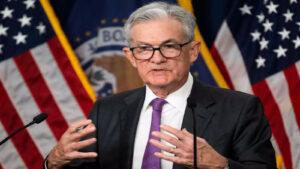In the dynamic world of finance, a single phrase from the Federal Reserve can send shockwaves through the stock market. Recently, the stocks experienced their most challenging day in four months, triggered by the carefully chosen words of Jay Powell, the central bank chair. Let’s delve into the intricacies of Powell’s statements and their profound implications for investors, shedding light on the evolving economic landscape.
Introduction: Unveiling the Market Rollercoaster
The recent turbulence in the stock market unfolded after Jay Powell addressed speculations about the Federal Reserve potentially cutting interest rates in March. Contrary to market expectations, Powell stated that it was not the “base case” for the central bank, causing a significant downturn in stocks.
Powell’s Assurance and Market Reaction
In an attempt to cool speculation, Powell emphasized the need for “greater confidence” in sustainably lower inflation before considering rate cuts. His words had an immediate impact on traders, leading to a sharp decline in stock prices. The S&P 500 suffered its worst day in four months, ending down 1.6%, while the Nasdaq Composite experienced a 2.2% drop, marking its worst day in three months.

Fed’s Unanimous Stand and Economic Resilience
Despite the market reaction, Powell reiterated that the Federal Open Market Committee unanimously agreed, for the fourth consecutive month, to maintain the benchmark federal funds rate between 5.25% and 5.5%. The surprising resilience of the US economy and labor market has defied earlier predictions, as the Fed’s efforts to combat inflation did not lead to the anticipated recession and job losses.
Hope for a Soft Landing
Amidst the economic uncertainties, there is a glimmer of hope for a so-called “soft landing” for the world’s largest economy. The steady fall in inflation over recent months has raised optimism, but Powell insisted on the need for more evidence before declaring victory over economic challenges.
Powell’s Caution and Economic Outlook
While acknowledging the benign economic backdrop, Powell remained cautious, stating that the economic outlook is still “uncertain.” He emphasized that bringing inflation back to the central bank’s 2% target is “not assured,” indicating that challenges persist despite the economy’s surprising resilience post-COVID-19.
Market Impact and Investor Sentiment
Following Powell’s comments, traders in the futures market adjusted their expectations, reducing the odds of a rate cut in March from 60% to 37%. Krishna Guha of Evercore ISI highlighted Powell’s clear message that a rate cut in March would only be considered in the face of a significant labor market downturn.

Change in Language and Economic Balancing Act
A notable shift in the committee’s statement was the removal of a bias towards further rate hikes. The statement now reads, “The committee judges the risks to achieving its employment and inflation goals are moving into better balance.” This alteration, as observed by Stephen Stanley, chief US economist at Santander, strikes a “nice balance” between eliminating the hiking bias and signaling that the Fed is not yet ready to ease monetary policy.
Focus on Wage Growth and Economic Indicators
The decision to maintain steady rates came on the heels of data indicating a moderation in wage growth. According to figures from the US Bureau of Labor Statistics, workers received a 4.2% increase in their pay packets over 2023, slightly down from 4.4% in the 12 months to September. This figure, however, still surpasses the latest readings of inflation, showcasing the Federal Reserve’s ongoing commitment to managing inflation effectively.
Powell’s Interpretation of Wage Growth
Powell interpreted the data, stating that low unemployment poses less of a threat to the Fed’s 2% inflation goal. He characterized the labor market as “getting back into balance,” emphasizing that it remains robust while acknowledging a slight slowdown in wage growth during the fourth quarter.
Expert Analysis and Market Reassurance
Experts, including Andrew Hunter, deputy chief US economist at Capital Economics, analyzed the latest data, pointing out that the slowdown in wage growth indicates easing labor market conditions, contributing to the downward pressure on inflation. Hunter suggests that this data is likely to “reassure” Fed officials that they are on course to achieve the 2% inflation target.
Conclusion: Navigating the Economic Landscape
In conclusion, Powell’s recent statements have unleashed a wave of uncertainty in the financial markets, reminding investors of the delicate balance the Federal Reserve must maintain. The market’s reaction underscores the sensitivity of investors to any shift in the central bank’s stance. As we navigate through these economic waters, staying informed and attuned to the evolving dynamics is key for investors looking to make strategic decisions in an ever-changing financial landscape. Stay tuned for further updates as we decode the intricacies of the market’s response to the Federal Reserve’s nuanced communications.
Disclaimer:
The information provided here is for general informational purposes only and should not be considered as financial advice. While we strive to present accurate and up-to-date information, we make no representations or warranties of any kind, express or implied, about the completeness, accuracy, reliability, suitability, or availability concerning the content. Any reliance you place on such information is strictly at your own risk.
Investing in financial markets carries risks, and past performance is not indicative of future results. It is recommended to seek professional advice tailored to your individual circumstances before making any financial decisions. We do not endorse or recommend any specific products, services, or companies mentioned in the content. The content may be subject to change without notice. By using this information, you acknowledge and agree to the terms of this disclaimer.




